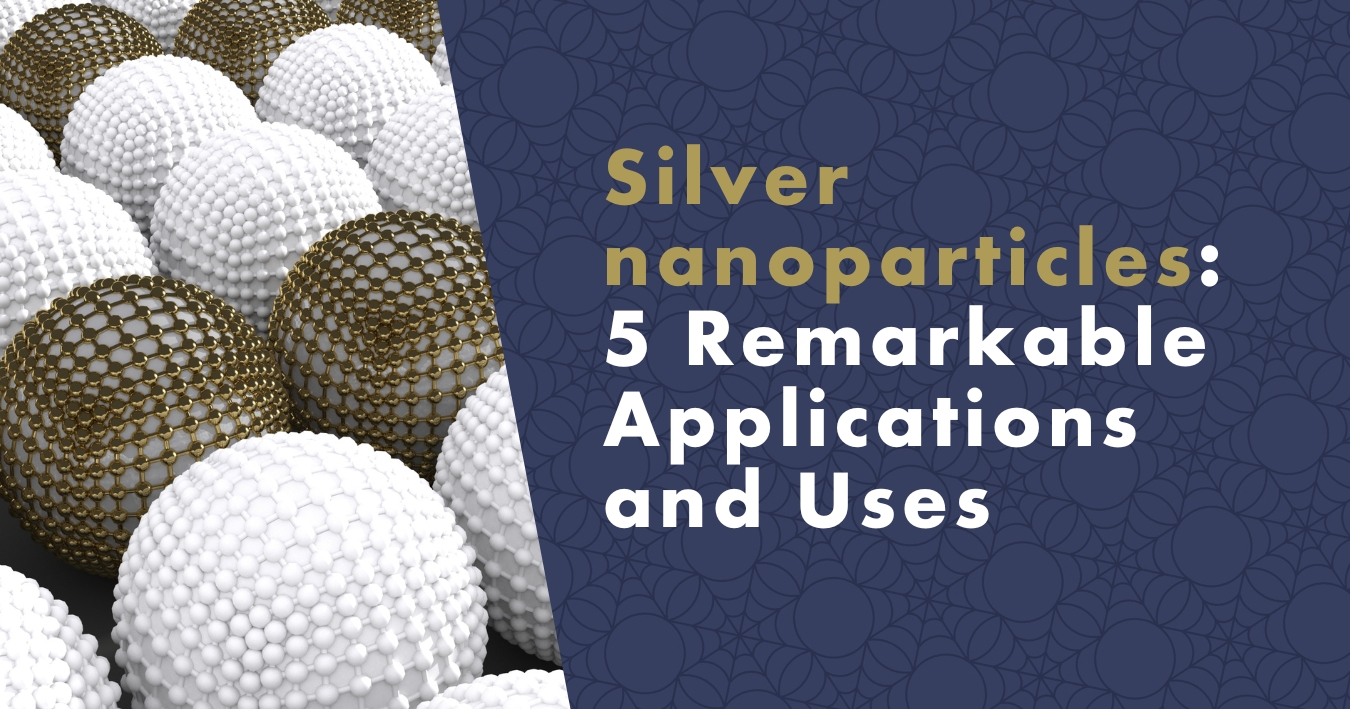Silver nanoparticles has garnered significant attention in recent years due to its unique properties and a wide range of potential applications. As a powerful antimicrobial agent, silver nanoparticles particles have been incorporated into various industries, from healthcare to consumer goods. In this article, we will explore five remarkable applications and uses of silver nanoparticles, showcasing its versatility and importance in our modern world. Join us as we delve into the fascinating world of silver nanoparticles and learn how this tiny powerhouse is making a big impact in diverse fields.

What Is Silver Nanoparticles (Colloidal Silver) and How Does It Work
Most of us imagine silver as a shiny, malleable material used in jewelry making, electronics, or medicine. However, this rare metal also exists in the form of small, 1 to 100 nanometer-sized particles dispersed in a solution (1,000,000 nm = 1 mm).
This state of matter is called silver nanoparticles (or colloidal silver) and has significant disinfectant properties - it suppresses bacteria, viruses, and fungi by a relatively simple mechanism. How?
Silver nanoparticles undergo partial oxidation in the air. This produces silver oxide, from which silver ions are released by the action of moisture. They bind to the cell membrane of the microorganism and basically "break it down". The pathogen dies, but that's not all. Silver ions are also transferred from its remains to microorganisms in the vicinity - and the whole cycle repeats.
Thanks to their microscopic dimensions, silver nanoparticles can easily be incorporated into various textiles, which leads to its wide application not only in healthcare and disinfection products but also in fashion.
Tip: Find out everything you need to know about silver nanoparticles in the next article.
Nano Silver Masks
silver nanoparticles-containing respiratory protection has recently gained popularity. Silver nanoparticles are firmly embedded in the fabric of masks, where all pathogens pass through during breathing.
According to a study published in 2021 in the scientific journal International Journal of Nanomedicine, silver nanoparticles suppresses the activity of the SARS-CoV-2 virus, which is responsible for the COVID-19 pandemic.
Silver textile masks are produced in a range of sizes and last around 100 wash cycles. They also come with a nanofilter pocket, which further enhances the effectiveness of the mask.
#products#https://www.nanospace.store/fashion-and-clothing/
Socks, T-shirts, and Other Clothing with Silver
Nanosilver in clothing effectively suppresses odor during excessive sweating. It eliminates bacteria and mold that feed on compounds excreted from the body and create odor-causing substances as a byproduct.
Also, clothing with nanosilver can last dozens or even hundreds of washing cycles. Thanks to the modern tradition of the nano-industry in the Czech Republic, you can choose from a range of textile products made domestically. By purchasing them, you contribute to the fight against climate change and unfair, cheap labor (and thus so-called fast fashion – see below).
Popular examples include silver socks, which eliminate odor even after intense athletic performance. Just let them dry:
- Sport Socks With Silver,
- Medical Socks,
- Terry Ankle Socks,
- Formal Socks With Silver,
- Compression Socks With Silver.
#produkty#https://www.nanospace.store/nano-socks/
Join the Slow Fashion Trend
There is also a growing market for T-shirts, tops, and dresses with nanosilver and thermoregulatory functions. Together with their "self-cleaning" ability (provided by the water-repellent surface made of nanoparticles), they become synonymous with the perfect lightweight garment in which you have almost no chance of sweating. And if sweating does occur, silver ions reliably eliminate any odor.
An example is the LADA by nanoSPACE collection of dresses, which embraces the slow fashion (slow fasion) trend. That is, an effort to purchase clothing so that its production and distribution have the least possible impact on the environment and are fair to the workers involved in its production. Lasting sustainability is also reflected in the lifespan of the textile – it is several times longer than clothing from discount chains.
#produkty#https://www.nanospace.store/fashion-and-clothing/
Bandages and Disinfectants with Nanosilver
Due to its microbicidal effects, silver has been used for thousands of years to treat wounds and promote healing. You can find products on the market, such as bandages with nanosilver additives and disinfectants, for example:
- StopBac STERILE Aquastop antibacterial water resistant patch,
- Anti-odor shoe spray Menthol 100ml,
- Travel disinfectant: OMG series F*CK COVID
Nanotechnology in the Fight against Climate Change
In addition to its health benefits, nanotechnology is also being used to combat climate change. One example is the use of silver nanoparticles in textiles to create self-cleaning and odor-resistant clothing. By eliminating the need for frequent washing, this technology reduces water and energy consumption, as well as the emission of pollutants from detergents and textile production.
Another application of nanotechnology is in the development of more efficient solar panels. By using nanomaterials, scientists are able to increase the surface area of solar cells, allowing them to capture more sunlight and produce more electricity. Nanotechnology is also being used to improve the energy efficiency of buildings, through the development of insulation materials and smart windows that can adjust to changing weather conditions.
Overall, nanotechnology has the potential to play a significant role in the fight against climate change and in the development of more sustainable technologies.

The Future of Silver Nanoparticles
As research on silver nanoparticles continues, new applications and benefits are likely to emerge. However, it is important to continue studying the potential risks associated with its use, particularly in the areas of environmental impact and human health.
Regulations and guidelines are being developed to ensure the safe and responsible use of nanotechnology, and it is important for both scientists and consumers to stay informed about the latest developments in this rapidly evolving field.
In conclusion, silver nanoparticles is a versatile and powerful technology with a wide range of applications in various fields. Its ability to eliminate harmful microorganisms and reduce odors has made it particularly valuable in the production of textiles and personal protective equipment, such as masks and gloves. As research continues, it is likely that silver nanoparticles will play an increasingly important role in improving our health and well-being, as well as in the development of more sustainable technologies.
Sources:
- Nowack, B., Krug, H.F., & Height, M. (2010). 120 years of nanosilver history: Implications for policy makers. Environmental Science & Technology, 45(3), 1177-1183.
- Project on Emerging Nanotechnologies. (2013). Consumer Products Inventory. (accessed on 3 June 2013).
- Hendren, C.O., Mesnard, X., Dröge, J., & Wiesner, M.R. (2011). Estimating production data for five engineered nanomaterials as a basis for exposure assessment. Environmental Science & Technology, 45(6), 2562-2569.
- Lansdown, A.B.G. (2004). A review of the use of silver in wound care: Facts and fallacies. British Journal of Nursing, 13(1), 6-19.
- Windler, L., Height, M., & Nowack, B. (2013). Comparative evaluation of antimicrobials for textile applications. Environment International, 53, 62-73.
- Fabrega, J., Luoma, S.N., Tyler, C.R., Galloway, T.S., & Lead, J.R. (2011). Silver nanoparticles: Behaviour and effects in the aquatic environment. Environment International, 37(2), 517-531.
- Glover, R.D., Miller, J.M., & Hutchison, J.E. (2011). Generation of metal nanoparticles from silver and copper objects: Nanoparticle dynamics on surfaces and potential sources of nanoparticles in the environment. ACS Nano, 5(11), 8950-8957.
- Liu, J., Wang, Z., Liu, F.D., Kane, A.B., & Hurt, R.H. (2012). Chemical transformations of nanosilver in biological environments. ACS Nano, 6(11), 9887-9899.
- Walser, T., Demou, E., Lang, D.J., & Hellweg, S. (2011). Prospective environmental life cycle assessment of nanosilver t-shirts. Environmental Science & Technology, 45(13), 4570-4578.
- Blaser, S.A., Scheringer, M., MacLeod, M., & Hungerbühler, K. (2008). Estimation of cumulative aquatic exposure and risk due to silver: Contribution of nano-functionalized plastics and textiles. Science of the Total Environment, 390(2-3), 396-409.
- Geranio, L., Heuberger, M., & Nowack, B. (2009). The behavior of silver nanotextiles during washing. Environmental Science & Technology, 43(21), 8113-8118.
- Promotion of Surgical Masks Antimicrobial Activity by Disinfection and Impregnation with Disinfectant Silver Nanoparticles
- Antimicrobial effects of silver nanoparticles
- Silver nanoparticles as a new generation of antimicrobials

